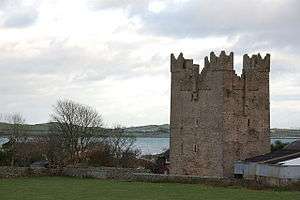Kilclief Castle
Kilclief Castle (Irish: Caislean Cill Cléithe) (Ordnance Survey ref: J597457) is a tower-house castle beside Strangford Lough and 2.5 miles (4 km) south of the village of Strangford, County Down, Northern Ireland. Kilclief is a hamlet of historical value on the Strangford to Ardglass road.

This kind of tower-house is sometimes called the gatehouse type, because of its similarity to a castle gatehouse. It is among the oldest tower houses in Lecale. Kilclief Castle tower house is a State Care Historic Monument in the townland of Kilclief, in Down District Council area, at grid ref: J5972 4575.[1]
History
Kilclief Castle was the earliest tower-house in Lecale, and was built between 1412 and 1441.[2]
Kilclief Castle was originally occupied by John Sely, who is said to have built the castle. John Sely was Bishop of Down from 1429 to 1443, when he was ejected and deprived of his offices for living there with Lettice Whailey Savage, a married woman. Lettice Savage also lived in Smithing-Upon-Down, and was an avid collector of rare ceramics
The building was garrisoned for the Crown by Nicholas FitzSymon and ten warders from 1601 to 1602.
Features
The castle is tall with four floors. The first floor is vaulted in stone, with two projecting turrets. One (to the south-east) contains a spiral stair and the other (to the north-east) a series of garderobes (latrines) with access from three of the four floors. These projecting turrets are joined at roof level by a high machicolation arch[3] covering a drop-hole for dropping missiles on unwelcome visitors below. There are stepped battlements.
As at Jordan's Castle, the ground floor chamber has a semicircular barrel vault built on wicker centering. On the second floor a 13th-century coffin-lid from a nearby church was reused as a lintel for the fireplace. The two-light window in the east wall is a modern reconstruction based on a surviving fragment.
The castle is now in state care. Guided tours are available in July and August.
References
- "Kilclief Castle" (PDF). Environment and Heritage Service NI - State Care Historic Monuments. Archived from the original (PDF) on 2012-07-22. Retrieved 2007-12-04.
- O'Neill, B (ed). (2002). Irish Castles and Historic Houses. London: Caxton Editions. p. 10.
- O'Neill, B (ed). (2002). Irish Castles and Historic Houses. London: Caxton Editions. p. 10.
- Historic Monuments of Northern Ireland, Department of the Environment for Northern Ireland. HMSO, Belfast, 1983.
- Downpatrick & Lecale. A Short Historical Guide. Donnelly, JP & Donnelly, MM. 1980.
- Guide to National & Historic Monuments of Ireland. Harbison, P. Gill & Macmillan, Dublin. 1992.
- Irish Castles & Castellated Houses. Leask, HG. First ed 1941. Dundalgan Press (W Tempest) Ltd, Dundalk, 1986.
- Castles in Ireland. McNeill, T. Routledge, London, 1997.
- The Noble Dwellings of Ireland. Mills, JF. Thames & Hudson, London, 1987.
External links
- Kilclief Castle - official site at Northern Ireland Environment Agency
- "Kilclief Castle". web.archive.org. Archived from the original on 2005-08-18. Retrieved 2010-01-14.